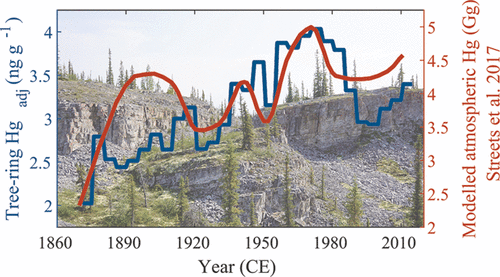当前位置:
X-MOL 学术
›
ACS Earth Space Chem.
›
论文详情
Our official English website, www.x-mol.net, welcomes your
feedback! (Note: you will need to create a separate account there.)
Tree-Ring Inferred Atmospheric Mercury Concentrations in the Mackenzie Delta (NWT, Canada) Peaked in the 1970s but Are Increasing Once More
ACS Earth and Space Chemistry ( IF 2.9 ) Pub Date : 2020-03-09 , DOI: 10.1021/acsearthspacechem.0c00003 Avneet Ghotra 1 , Igor Lehnherr 1 , Trevor J. Porter 1 , Michael F. J. Pisaric 2
ACS Earth and Space Chemistry ( IF 2.9 ) Pub Date : 2020-03-09 , DOI: 10.1021/acsearthspacechem.0c00003 Avneet Ghotra 1 , Igor Lehnherr 1 , Trevor J. Porter 1 , Michael F. J. Pisaric 2
Affiliation

|
Mercury (Hg) is a global pollutant emitted to the atmosphere from anthropogenic sources, which have varied over time in response to increased industrialization and pollution control measures. Tree rings have shown promise for reconstructing past atmospheric Hg(0) concentrations to expand on the temporally and spatially limited data provided by the instrumental record, producing high-resolution data with absolutely dated chronologies. Here, we present a ∼400 year reconstruction of atmospheric Hg(0) based on white spruce (Picea glauca) tree rings from a pristine coastal area in Northwestern Canada (Mackenzie Delta, Northwest Territories). The tree-ring record shows that Hg concentrations did not begin to increase significantly above baseline until ∼1875, coinciding with increased industrialization in Europe and North America. Hg concentrations reached a maximum in the 1970s and subsequently declined until the end of the 20th century, which is consistent with the trends in modeled global tropospheric Hg(0) concentrations based on the latest Hg-emission inventories. However, unlike many other locations in the northern hemisphere, the Mackenzie Delta tree-ring record exhibits a rebound in Hg(0) concentrations since the turn of the century, likely reflecting the increase in upwind Asian industrial emissions. The relative enrichment in inferred modern atmospheric Hg(0) relative to preindustrial concentrations [enrichment factors (EF) = 1.54] is similar to other EF values obtained from tree rings, but lower than those based on models and sedimentary archives. Tree-ring Hg concentrations in the Mackenzie Delta were higher than at a continental site also located in northwestern Canada, suggesting that ocean Hg(0) evasion and permafrost slumping contribute to higher local atmospheric concentrations.
中文翻译:

Mackenzie三角洲(加拿大NWT)的树木年轮推断大气中的汞浓度在1970年代达到顶峰,但随后又增加了
汞(Hg)是人为源排放到大气中的一种全球污染物,随着工业化和污染控制措施的增加,汞的含量随着时间的推移而变化。年轮已显示出有望重建过去的大气Hg(0)浓度,以扩大仪器记录提供的在时间和空间上有限的数据的能力,从而产生具有绝对年代的高分辨率数据。在这里,我们提出了基于白云杉(云杉云杉)的大气Hg(0)的〜400年重建)来自加拿大西北部(西北地区Mackenzie三角洲)原始沿海地区的年轮。树木年轮的记录显示,直到1875年左右,汞的浓度才开始显着增加到基线以上,这与欧洲和北美的工业化发展相吻合。汞浓度在1970年代达到最大值,然后下降到20世纪末,这与根据最新的汞排放清单模拟的全球对流层Hg(0)浓度的趋势一致。但是,与北半球许多其他地区不同,自本世纪初以来,麦肯齐三角洲的年轮记录显示Hg(0)浓度有所回升,这很可能反映了亚洲上风工业排放的增加。推断的现代大气Hg(0)相对于工业化前浓度的相对富集[富集因子(EF)= 1.54]与从树年轮获得的其他EF值相似,但低于基于模型和沉积档案的值。Mackenzie三角洲的树木年轮中的Hg浓度也高于加拿大西北部的一个大陆站点,这表明海洋Hg(0)的逃逸和多年冻土层的塌陷导致当地大气浓度升高。
更新日期:2020-03-10
中文翻译:

Mackenzie三角洲(加拿大NWT)的树木年轮推断大气中的汞浓度在1970年代达到顶峰,但随后又增加了
汞(Hg)是人为源排放到大气中的一种全球污染物,随着工业化和污染控制措施的增加,汞的含量随着时间的推移而变化。年轮已显示出有望重建过去的大气Hg(0)浓度,以扩大仪器记录提供的在时间和空间上有限的数据的能力,从而产生具有绝对年代的高分辨率数据。在这里,我们提出了基于白云杉(云杉云杉)的大气Hg(0)的〜400年重建)来自加拿大西北部(西北地区Mackenzie三角洲)原始沿海地区的年轮。树木年轮的记录显示,直到1875年左右,汞的浓度才开始显着增加到基线以上,这与欧洲和北美的工业化发展相吻合。汞浓度在1970年代达到最大值,然后下降到20世纪末,这与根据最新的汞排放清单模拟的全球对流层Hg(0)浓度的趋势一致。但是,与北半球许多其他地区不同,自本世纪初以来,麦肯齐三角洲的年轮记录显示Hg(0)浓度有所回升,这很可能反映了亚洲上风工业排放的增加。推断的现代大气Hg(0)相对于工业化前浓度的相对富集[富集因子(EF)= 1.54]与从树年轮获得的其他EF值相似,但低于基于模型和沉积档案的值。Mackenzie三角洲的树木年轮中的Hg浓度也高于加拿大西北部的一个大陆站点,这表明海洋Hg(0)的逃逸和多年冻土层的塌陷导致当地大气浓度升高。











































 京公网安备 11010802027423号
京公网安备 11010802027423号